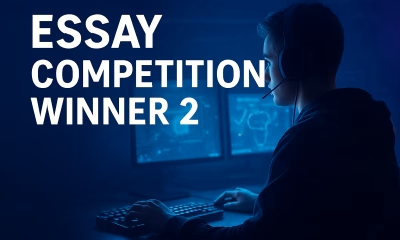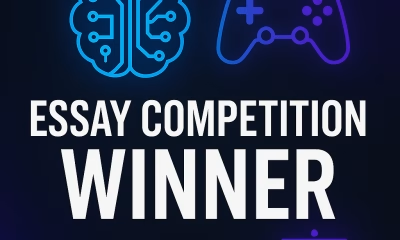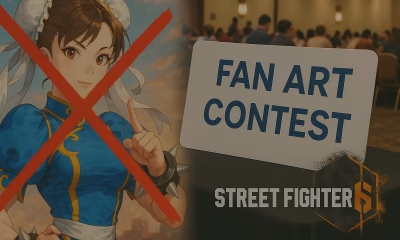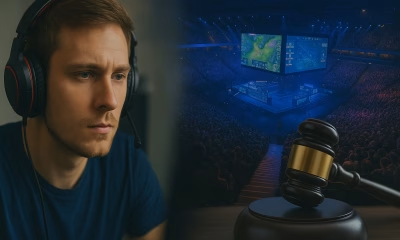General
Esports Legal News Essay Competition Winner #3: The legal arena of esports: Intellectual property in a global digital battleground
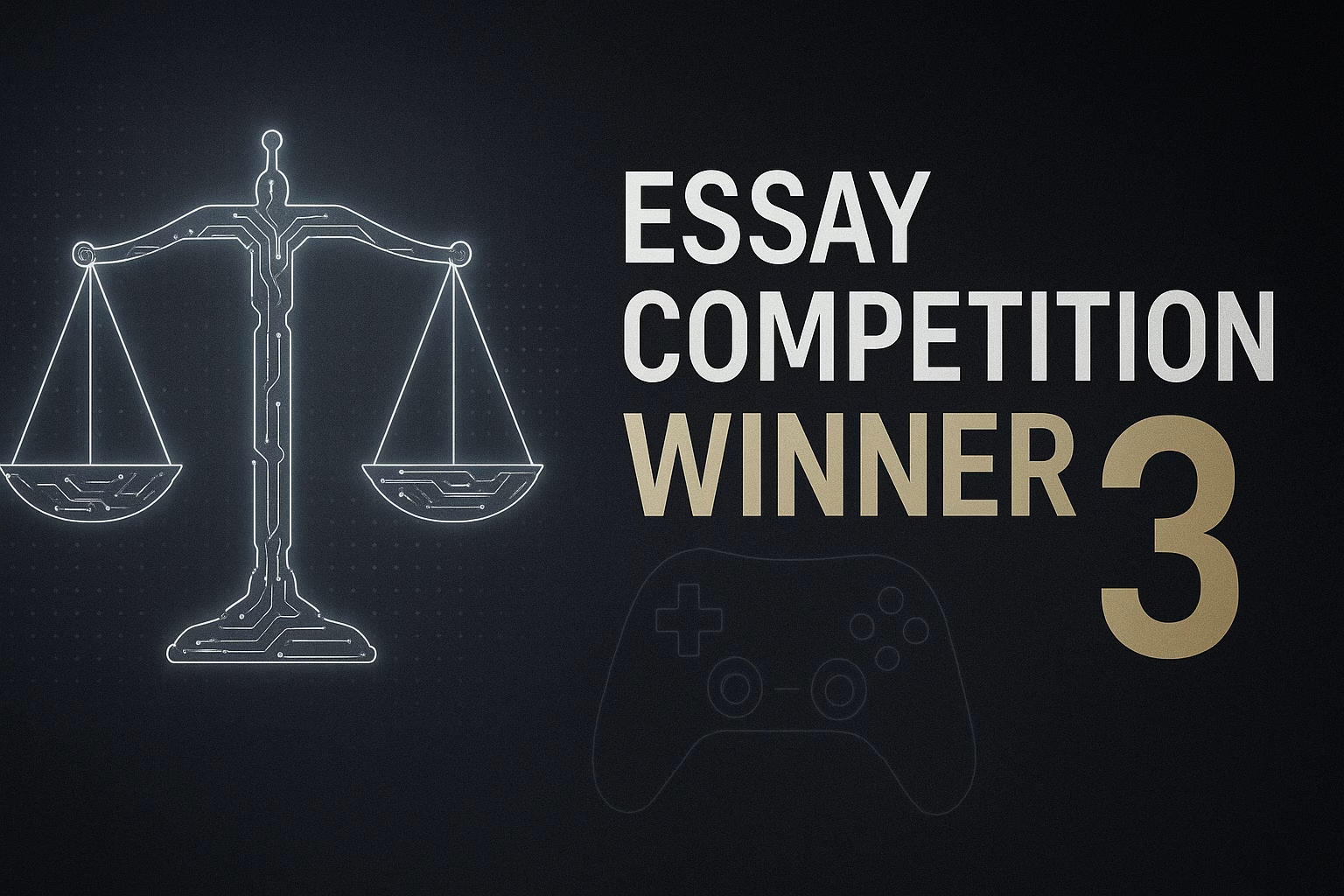
We’re proud to conclude our Essay Competition series with the third and final winning essay.
This week’s essay, “The legal arena of esports: Intellectual property in a global digital battleground” by Călin Ioan Mihalache brings fresh insight into the evolving intersection of esports, law, and technology.
Table of Contents
Introduction
Esports has exploded globally, spawning vast markets for digital assets and media rights. The industry now revolves around virtual goods, user-created content, and branded entities that intersect classical intellectual property regimes. Understanding how European law treats these new categories is critical to stakeholders. This essay examines the legal framework governing ownership of in-game content, user-generated content, trademarks in esports, and broadcasting rights, focusing on EU directives, CJEU case law, and comparative practices.
Esports events involve high-stakes competition and extensive digital assets. The visual above shows professional players at a major tournament, highlighting the convergence of entertainment and IP, from the game software and character designs to the league branding and broadcast feeds. Esports competitors rely on developers’ licensed software and virtual items, raising questions about who legally owns these digital items, the status of fan-made mods and streams and how trademarks and broadcasting rights are protected under European and international law.
Section I – Ownership of in-game content, user-generated content, trademarks in esports, broadcasting and streaming rights
Ownership of in-game content
Video games and their in-game assets are protected as creative works under EU copyright law. In Nintendo Co. Ltd v PC Box, the CJEU held that a video game “constitute[s] complex matter comprising not only a computer program but also [creative] graphics and sound elements”[1]. These audiovisual components have “unique creative value” and, if original, are protected together with the entire work under Directive 2001/29/EC. In other words, a video game is not merely software, but a broader creative work. As a result, the game developer or publisher holds exclusive rights to reproduce and distribute the entire game and its assets.
End-User Licensing Agreements (EULAs) typically reinforce this arrangement by expressly granting users only a licence to use the game, not ownership. Under EU law, the first sale of a copyrighted work exhausts distribution rights only in respect of physical copies[2]. Importantly, the CJEU has clarified that exhaustion does not apply to digital copies of general copyrighted works. In UsedSoft GmbH v Oracle, the Court established that the first sale of a software copy exhausts the distribution right because software falls under a special regime that counts downloads as sale[3]. However, in Tom Kabinet[4], the Court held that the resale of digital books could not exhaust rights because books are protected under the general regime and exhaustion only applies to physical copies. Building on these distinctions, the French Cour de Cassation recently ruled that digital video games likewise fall under the general copyright regime, not the software lex specialis. It confirmed that a Steam subscription contract’s prohibition on reselling digital games was valid, since “video games are protected by the general regime of copyright, which allows the exhaustion of rights only on physical copies”. In short, under EU law the developer retains ownership of in-game software and assets, and digital “sales” of games or items are treated as licensed uses.
The EU Software Directive still limits its exhaustion rule to computer programs, so downloadable games exhaust only their software component. The remaining creative content enjoys exclusive copyright under the InfoSoc Directive. EULAs often stress this point, barring resale or transfer of accounts and items. These contractual limits generally hold in the EU so long as they do not contravene mandatory consumer protections. Moreover, the law protects technical measures, as the CJEU has endorsed “robust” protection for encryption and anti-circumvention measures on games consoles[5], reflecting obligations under the 2001 WIPO Copyright Treaty.
In practice, this means that most virtual assets are owned by the game company. Even if a user acquires a skin by playing or purchase, the skin is typically a license from the developer. No property right is conferred unless explicitly granted. Some new technologies, such as NFTs, can certify ownership of a tokenised item, but the NFT itself does not automatically confer copyright or circumvent the above rules. On balance, EU law treats in-game content as intellectual property of the game owner.
User-generated content
User-generated content (UGC) in games encompasses mods, custom skins, fan art, maps, streams, content created by players or fans using the game as a platform. Under EU copyright law, UGC is generally disfavoured unless it qualifies as an exception. UGC typically mixes the game’s existing copyrighted elements with new creative input. Some UGC might be sufficiently original, but more often it is derivative. In the EU a derivative requires the rightsholder’s permission. In practice, without express consent or licence, modders and skin creators risk infringing the developer’s copyright[6].
No broad “fair use” exception exists in the EU for gaming content. The InfoSoc Directive permits only limited mandatory exceptions. DSM Directive 2019/790 added exceptions like parody, but these are narrow and unlikely to shield most mods or fan art. Thus, unauthorised distribution of game mods or assets typically infringes copyright. Online platforms or game companies can be forced to remove infringing UGC if notified.
Recognising this uncertainty, game companies regulate UGC heavily by contract. End-user licenses frequently stipulate what players may create or share. Developers often grant users the right to create certain content, but simultaneously secure from the user a licence to exploit that content. Typically, the game’s EULA or user agreement says the user grants the developer an irrevocable license to host, distribute, and even publicise the created material. For example, many titles allow players to upload fan videos or custom maps, but only on official platforms. The agreement gives the developer permission to reuse those creations in marketing. This means players do not own their creations in a broad sense.
Some companies carve out limited freedom to encourage a community, but these operate by licence rather than implying full ownership. In a few cases, platforms allow modders to monetise content under specified rules. However, such schemes still rely on a contract, as the developer maintains ultimate control and copyright. In contrast, U.S. law sometimes affords more leeway though fair use. China likewise protects game assets as copyright and has few special provisions for mods.
Thus, in the EU and internationally, most UGC in games is either an authorised derivative work or unlicensed infringement. Rights holders enforce their copyright if UGC goes beyond permitted uses. Only a few exceptions, such as parody or private use, apply marginally, and no EU rule grants blanket rights to fan creators. Licensing remains the dominant model for UGC in esports.
Trademarks in esports
Trademarks are vital to the esports brand ecosystem. Team names, league titles, game titles, sponsor logos, and even in-game character likenesses are often registered as trademarks. In the EU, the basic framework is Regulation (EU) 2017/1001 on European Union trademarks. An EU trademark (EUTM) confers a monopoly over the sign for specified goods or services across the EU. Thus, a game publisher can register its game’s title or distinctive logo as a Class 9 or Class 28 mark, covering software, entertainment services, or merchandise. Team owners register team logos and names as marks for clothing or events. Sound logos or animated logos can be registered as “motion marks”.
Distinctiveness and non-confusion are key. The EUIPO Observatory notes that marks for game titles and characters can be protected if they are inherently distinctive or have acquired distinctiveness[7]. In one General Court case, the mark DUNGEONS was found confusingly similar to the registered DUNGEONS & DRAGONS trademark for similar goods. That decision illustrates enforcement, as even partial overlap in a gem-related name can cause refusal of an application or basis for infringement. Conversely, slight differences can avoid conflict, as in T-491/22 two fantasy-style logos were deemed not confusingly similar.
Virtual goods themselves are recognised by trademark offices. The EUIPO treats “virtual goods” (such as in-game skins or items) as Nice Class 9, downloadable digital content[8]. It even allows marks on NFTs that certify digital art. This signals that a creator can seek trademark protection for unique digital designs sold in games. Brands in esports vigorously enforce their marks, an unauthorised stream or merch imitating an official team mark can be enjoined under EU law.
In practice, a well-known esports brand carries great value for sponsorship and merchandise. Teams and leagues typically register their identities across all relevant classes, including clothing, media, or online services. Enforcement follows standard EU trademark law, namely if a fan or rival used a confusingly similar logo or name, the trademark owner could seek cancellation or damages. EU law provides for injunctions, damages and even customs seizure of counterfeit goods. Internationally, the U.S. Lanham Act provides similar rights. In China, trademark law means savvy companies often pre-register popular esports names in China to prevent copycats. Overall, trademark protection in esports secures brand identity globally, just as in traditional sports and entertainment.
Broadcasting and streaming rights
Esports matches today attract television and streaming deals comparable to traditional sports. The key question is who holds the rights to broadcast or stream an esports event. Traditionally, the organisers hold the copyright in the audio-visual production of the event, and they bundle this as broadcasting rights sold to TV networks or online platforms. In EU law, the underlying competition is not independently copyrighted as the CJEU has ruled for sports, “sports events as such do not qualify as protected subject matter” under the copyright directive[9]. By analogy, the gameplay of an esports match is not an original work of authorship” and attracts no copyright. What is protected is the audio-visual fixation of the event, namely camera angles, commentary, overlays, or stage design. Under Directive 2001/29/EC, the producer of the first fixation of a “film” has exclusive rights over that broadcast copy[10]. Similarly, the broadcasting organisation holds rights in the broadcast signal itself.
Therefore, the event organiser normally owns the copyright in the live video of the match. Only they may communicate the event to the public. A live stream on Twitch by a content creator of an official match would infringe the organiser’s and broadcaster’s rights if done without permission, since the act of making available to the public is reserved to the rights holder[11]. Large tournaments routinely sign exclusive deals (for instance, Riot Games streaming League of Legends World Championship on Twitch) to authorise official coverage. Others are explicitly prohibited from rebroadcasting. The EU Information Society Directive grants the copyright owner the exclusive right to authorise any “communication to the public” of their work, which covers live streaming.
The EU has also established rules on retransmission of broadcast content. Directive (EU) 2019/789 clarifies that the country-of-origin principle does not apply to sports events[12]. In practice this means member states may restrict cross-border streaming of sports and similar events unless licensed. Applied to esports, this allows rights holders to control where streams are shown. In April 2023, the European Commission explicitly recommend member states and platforms to crack down on unauthorised streaming of live sports and esports. For example, live pirate streams of major tournaments can be blocked or taken down under EU rules.
Public performance and retransmission exceptions generally do not cover high-profile esports broadcasts. While casual viewing is not restricted, commercial rebroadcast requires licence. EU law does provide an exception for transient temporary copies which may, for example, allow short data caching by streaming platforms, but this does not undermine the organiser’s communication rights.
Internationally, the situation is broadly similar. In the US, esports leagues sell streaming rights under agreements, as unauthorised public streaming violates both copyright and trademark. U.S. courts have held that unauthorised retransmission of live sports signals infringes if broadcast without consent. China’s approach is more restrictive. For instance, major esports events typically require state broadcasting licenses, and online platforms must secure rights from game publishers. China has cracked down on illegal streaming under its Copyright Law and new anti-piracy regulations.
The holder of an esports match’s broadcasting rights is generally the organiser who produced the live stream. They rely on EU copyright and related rights to exclude unauthorised streaming. Anti-piracy measures reinforce these protections, and courts have analogised esports to traditional sports in refusing to treat the competition itself as a copyrightable work.
In summary, EU law affords strong intellectual property protection to game developers and esports organisers across multiple domains. In-game content remains the exclusive property of the developer, with players granted only limited licenses governed by EULAs. User-generated content, while central to player engagement, is largely treated as derivative and subject to the rights holder’s permission, typically regulated through contractual licensing. Trademarks underpin brand identity in esports, with EU trademark law ensuring strong protection against unauthorised use. Finally, broadcasting and streaming rights in esports events rest with the organiser, who controls the audiovisual fixation of the match and may enforce exclusive communication rights under the InfoSoc Directive. Together, these legal frameworks establish a structured and enforceable regime for ownership, use and dissemination of esports content within the EU.
Section II – Liability and enforcement challenges in esports IP infringement
Liability and enforcement challenges in esports IP infringement
Esports presents unique challenges in the enforcement of intellectual property rights. Unlike traditional sports, the core content of esports is protected by copyright and related IP rights owned by game publishers or tournament organisers. When infringements occur, identifying and holding perpetrators accountable is complex due to the digital cross-border nature of esports.
Enforcing IP rights in esports faces challenges in identifying infringers and their locations. In the online environment, users can hide behind pseudonyms and VPNs, complicating the process for rights-holders. Platforms like YouTube and Twitch often collect limited user data and may not verify identities, making it difficult to pursue enforcement. Cross-border issues further complicate matters, as infringing actions can involve multiple jurisdictions, requiring international cooperation for effective enforcement.
Intermediary liability in Esports: EU frameworks
The EU’s intermediary liability framework is based on the e-Commerce Directive, which provides a safe harbour[13] for platforms hosting user-generated content, protecting them from liability unless they have actual knowledge of illegal activities. Article 14 of the Directive provides that hosting service providers are not liable for illegal content if they lack actual knowledge of the illegality or act quickly to remove it upon obtaining knowledge[14]. This safe harbour aims to strike a balance between holding platforms accountable and not imposing an impossible burden of monitoring every user upload.The Digital Services Act updates this framework, reinforcing these protections but imposing new duties on platforms, such as user-friendly notice-and-takedown systems. A key development is the Digital Single Market Directive, which holds large platforms accountable for user-uploaded copyrighted content unless they implement proper content monitoring measures.
Crucially, under EU law, intermediaries cannot be subjected to a general obligation to monitor or proactively seek out infringements, a principle affirmed by the CJEU in cases like Scarlet Extended[15]and SABAM v Netlog[16] which struck down injunctions that would require indiscriminate filtering of user content as incompatible with fundamental rights.
The Digital Services Act (DSA) updates the EU’s intermediary liability framework while retaining the core safe harbour provisions of the E-Commerce Directive, ensuring that platforms are generally immune from liability user-generated content unless they have actual knowledge of illegal material and fail to remove it after being notified. The DSA includes a good Samaritan provision, encouraging platforms like Twitch to voluntarily moderate content without losing their safe harbour immunity. It also upholds the principle that no general monitoring obligation can be imposed on platforms.
In relation to intellectual property, article 17 of the Digital Single Market Directive holds large content sharing platforms directly liable for user-uploaded copyrighted content unless they obtain licenses or apply effective filtering measures. transparency and redress requirements. Furthermore, even when intermediaries are not liable, rights holders can still seek injunctive relief, such as blocking access to infringing content. EU case law[17]supports the use of site-blocking injunctions to enforce IP rights, highlighting the increasing acceptance of such measures in the digital space.
Enforcement mechanisms for IP holders in esports
Rights-holders in esports have several legal enforcement mechanisms at their disposal to combat IP infringement.
The first line of defence is typically sending notices to platforms hosting infringing content. Under EU safe harbour regimes, platforms that receive a valid notice are required to remove or disable access to the content to maintain immunity from liability. This mechanism is widely used for esports content. For example, if an individual uploads highlights of a tournament on YouTube without permission, the organiser or publisher can issue a takedown notice under the DMCA or the platform’s copyright policies, leading to removal of the video. The challenge is that takedowns are reactive and often after the fact. In live streaming, by the time a notice is processed, the infringing stream may have already broadcast a full match to viewers. Some platforms do offer more immediate tools, Twitch for instance, that has a system to stream-snipe infringing live content. Moreover, notice-and-takedown can be abused or lead to collateral damage, like false claims or automated over-blocking can interfere with legitimate user-generated content, raising concerns about chilling effects on the community[18].
Where immediate or more drastic action is needed, rights-holders may seek court orders to prevent or halt infringement. Injunctions can be aimed at the infringer directly or at intermediaries. Interim injunctions are especially valuable in the fast-paced esports environment. Courts will consider the balance of convenience and the likelihood of irreparable harm. In the EU, article 8 (3) InfoSoc Directive injunctions against intermediaries are a powerful tool, even if the intermediary has no liability. The UK High Court has employed dynamic injunctions to combat live sports piracy, allowing real-time blocking of servers during Premier League football matches. A key difficulty with injunctions is enforcement, as an order against a specific website or user may be circumvented by mirrors or aliases. Thus, rights-holders often engage in a whack-a-mole game and injunctions need to be coupled with monitoring and follow-up.
Although esports IP is largely digital, customs enforcement can play a role, particularly regarding trademark counterfeits and certain copyright goods. The EU and many countries allow IP owners to register their rights with customs authorities so that counterfeit physical goods can be seized at the border. In the context of live events, customs measures might extend to equipment imported for pirate streaming setups or unlicensed broadcast gear. While traditional border measures have limited reach against purely online piracy, they are part of a comprehensive enforcement strategy to protect the esports ecosystem’s IP. The challenge remains that digital content moves instantaneously across borders, so physical checkpoints have a marginal role in stopping, a stream from being accessed.
In employing these mechanisms, IP holders in esports often must act in a multi-jurisdictional way, by issuing takedowns globally, litigating in the most relevant or favourable courts and cooperating with law enforcement for any criminal dimensions. The costs involved mean that enforcement is often selective. Many infringements by individual fans, such as non-commercial streaming, might be tolerated or handled via platform policies rather than full legal escalation. This aligns with the community-driven nature of esports, where publishers often prefer to maintain good will and only clamp down on flagrant or harmful infringements, such as bootleg streams that compete with official broadcasts or cheat sellers undermining game integrity.
The enforcement of intellectual property rights in esports operates within a complex legal and technological landscape. While EU law offers a solid framework, practical enforcement remains challenging due to anonymity, cross-border activity and the speed of digital dissemination. Rights-holders must navigate a balance between protecting their IP and maintaining community engagement, often relying on a combination of reactive takedowns, proactive monitoring, legal action and strategic tolerance. Ultimately, effective IP enforcement in esports requires coordinated efforts across platforms, jurisdictions and legal tools to uphold rights without constraining innovation or user participation.
Section III – Reflections, recommendations and final conclusions
Reflections and recommendations on EU Esports IP Law
The EU legislature should consider an exception for transformative, non-commercial esports content to legalise what is socially beneficial creativity. Alternatively, the commission could issue guidance or promote industry codes that grant users baseline freedoms to create content, reducing legal uncertainty and fostering community growth.
Through the envisioned European Video Game observatory or direct stakeholder dialogues, best practices for licensing in esports should be developed, ensuring that independent tournament organisers can access game licenses on fair terms and discouraging total exclusivity that shuts out grassroots competition. The aim would be to keep the esports scene open and competitive while respecting IP.
While not an IP law change per se, the EU and national bodies can encourage recognition of player associations and collective agreements that secure a share of revenues and reasonable terms in contracts. This would mitigate the current imbalance where IP owners have all rights and players must consent. If players cannot have IP rights, they should at least have contractual rights for compensation and input in decisions like media deals that affect them.
At this stage, a sui generis esports event right should not be introduced, as the existing copyright framework is adequate and adding rights could create overlaps. The focus should be instead on enforcement mechanisms for existing rights.
Cooperation at the EU level should be scaled up to combat unauthorized restreams of esports events and sale of unlicensed merchandise. Eurojust or Europol could coordinate on major piracy networks affecting European esports broadcasts. Additionally, rightsholders could be empowered with injunction tools as done in some member states for sports. This protects the economic incentive to invest in professional esports.
The European commission’s competition unit should be tasked with keeping an eye on esports market structures. If a publisher’s practices are harming consumers or aspiring competitors, they should be prepared to use antitrust enforcement or regulatory pressure to open the space. The goal is not to diminish IP, but to prevent abuse of IP-driven dominance.
In future revisions of consumer law, provisions addressing virtual goods should be integrated, which possibly give consumers more rights to their purchased in-game items, such as portability, inheritance rights, a controlled resale right or the right to gift or transfer items. This would modernise the concept of ownership in the digital era and give esports players more security in their investments. It would need to be balanced with the legitimate need of IP holders to guard against piracy and cheats.
Conclusion
Esports sits at the intersection of intellectual property law, applying classical doctrines to digital phenomena. Under EU law the in-game assets and software remain the protected property of the developers or publishers[19] and the players receive licenses subject to the terms of service. User-generated creations are similarly controlled, with official policies and contracts governing what fans may create and distribute. Trademark law underpins the industry’s brand value, safeguarding team, league and game identities as EU trademarks. Finally, the rights to broadcast and stream matches follow the pattern of sports broadcasting whereby event organisers exercise exclusive communication rights over their live streams, defended by EU directive provisions and case law.
As the esports market continues to evolve, legal frameworks will adapt. Recent developments show a trend towards clarifying rights in digital content. For now, those involved in esports should apply established IP principles, in particular respecting developers’ copyrights and trademarks, abiding by licence terms, and obtaining proper authorisations for streaming. In doing so, they ensure that Europe’s digital battleground remains both vibrant and legally coherent.
[1] www.curia.europa.eu, Case C-355/12 Nintendo Co. Ltd and Others v PC Box Srl and 9Net Srl.
[2] www.eur-lex.europa.eu, Directive 2001/29/EC of the European Parliament and of the Council of 22 May 2001 on the harmonisation of certain aspects of copyright and related rights in the information society.
[3] Case C-128/11 UsedSoft GmbH v Oracle International Corp.
[4] Case C-263/18 Nederlands Uitgeversverbond and Groep Algmene Uitgevers v Tom Kabinet Internet BV and Others.
[5] www.videogameseurope.eu , CJEU Ruling in Nintendo v PC Box case, Video Games Europe, 28 January 2014.
[6] www.esportslegal.news Dr. Amy Thomas, User-generated Content (UGC) – Esports, EsportsLegal, 21 April 2024.
[7] Game on: Navigating intellectual property in esports, EUIPO, 10 June 2024.
[8] www.hoganlovells.com, Anthonia Ghalamkarizadeh, Dr. Andreas Renck, Virtual goods and NFTs- IP protection of digital assets in gaming, social media and the metaverse, Hogan Lovells, 7 September 2022.
[9] Tatiana Synodinou, Copyright law and Football Matches: Impossible to Match? (part I), Kluwer Copyright Blog, 4 January 2022.
[10] Directive 2001/29/EC of the European Parliament and of the Council.
[11] Ibid.
[12] Directive (EU) 2019/789 OF THE EUROPEAN PARLIAMENT AND OF THE COUNCIL of 17 April 2019, laying down rules on the exercise of copyright and related rights applicable to certain online transmissions of broadcasting organisations and retransmissions of television and radio programmes, and amending Council Directive 93/83/EEC.
[13] www.lw.com, The Digital Services Act: Practical Implications for Online Services and Platforms, Latham & Watkins LLP, March 2023.
[14] Directive 2000/31/EC of the European Parliament and of the Council of 8 June 2000 on certain legal aspects of information society services, in particular electronic commerce, in the Internal Market.
[15] Case C-70/10, Scarlet Extended SA v SABAM, 24 November 2011.
[16] Case C-360/10, SABAM v Netlog, 16 February 2012.
[17] Case C-314/12, UPC Telekabel Wien GmbH v Constantin Film Verleih GmbH and Wega Filmproduktionsgesellschaft mbH, 27 March 2014.
[18] Jenny Parl, Copyright and the Esports industry, Columbia Business Law Review, 15 December 2019
[19] Edouard Fortunet, Jakob Guhn, Cyril Philibert, Rebecca Swindells, French Supreme Court Rules on Resale of Digital Video Games, Lexology, 23 October 2024.


